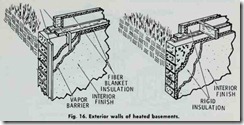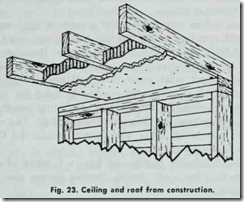Crawl Space Exterior Walls
The exterior walls of unvented crawl spaces should be in sulated with a materia] providing a thermal resistance of at least R-7 or better. A method for doing this is illustrated in Fig. 17. No insulation is required for the exterior walls of vented crawl spaces.
Walls Between Separately Heated Dwelling Units
Where walls separating adjacent but independently heated dwelling units occur, insulation with a thermal resistance of at least R-11. The insulation may be placed in either wall or divided proportionally between them (Fig. 18).
Wood or Metal Joist Frame Floors
Wood or metal joist floors over unheated basements or vented crawl spaces should have a maximum U-factor of 0.07 (requiring insulation rated at R-11 or greater). Three methods for providing insulation are illustrated in Figs. 19, 20 and 21.![Fig.-18.-Walls-between-adjacent-sepa[2] Fig.-18.-Walls-between-adjacent-sepa[2]](http://machineryequipmentonline.com/hvac-machinery/wp-content/uploads/2020/04/Fig.-18.-Walls-between-adjacent-sepa2_thumb1.jpg)
Concrete Floors
Concrete floors over unheated spaces should have a maximum U-factor of 0.11 requiring insulation rated at R-7 or greater. The following three methods are recommended for applying a layer of insulation:
1. Spray rigid insulation in a suitable thickness on the under side of the floor.
2. Bond preformed rigid insulation to the top or bottom of the surface.
Slab-On-Grade Floors
Insulation rated R-5 is required for all slab-on-grade floors. Two methods for insulating slab-on-grade floors is illustrated in Fig. 22. Table 3 lists the maximum heat losses in terms of watts and Btuh per linear foot of exposed slab edge as recommended by the Electric Energy Association. More information can be obtained from the FHA Minimum Property Standards.
Floors of Sandwich Construction
Floors of sandwich construction should be insulated in the same manner as sandwich walls (see above).
Table 3. Slab edge heat loss.
Frame Ceilings and Roofs
Any ceiling below an unheated space should be insulated with materials having a rating of R-19 or better. The ceilings should have a maximum U-factor of 0.05. Among the various methods for providing such insulation are:
1. Staple blankets or batts to the joists before the finished ceiling is applied (Fig. 23).
2. Blow or manually apply loose insulation between ceiling joists from above.
3. Spray on insulation between the joists from above.
Concrete Ceilings
Concrete ceilings below unheated spaces should have a maxi mum U-factor of 0.07, requiring insulation rated R-11 or greater. The following methods are suggested for insulating concrete ceilings:
1. Attach preformed rigid insulation to either surface with adhesives.
2. Apply sprayed-on rigid insulation to either surface.
3. Make a sandwich constructon with preformed rigid in sulation formed around a concrete core.
4. Apply rigid insulation to the top surface where the ceiling also serves as the roof of the structure.
Sandwich Ceilings
Ceilings of sandwich construction below unheated spaces should have a maximum U-factor of 0.05, requiring insulation rated at R-19 or better. Sandwich ceilings that also serve as the roof of a structure meet the same requirements.

![Fig.-17.-Exterior-walls-of-unvented-[1] Fig.-17.-Exterior-walls-of-unvented-[1]](http://machineryequipmentonline.com/hvac-machinery/wp-content/uploads/2020/04/Fig.-17.-Exterior-walls-of-unvented-1_thumb1.jpg)
![Fig.-19.-Frame-floor-construction-wi[2] Fig.-19.-Frame-floor-construction-wi[2]](http://machineryequipmentonline.com/hvac-machinery/wp-content/uploads/2020/04/Fig.-19.-Frame-floor-construction-wi2_thumb1.jpg)
![Fig.-20.-Frame-floor-construction-wi[2] Fig.-20.-Frame-floor-construction-wi[2]](http://machineryequipmentonline.com/hvac-machinery/wp-content/uploads/2020/04/Fig.-20.-Frame-floor-construction-wi2_thumb1.jpg)
![Fig.-21.-Frame-floor--construction--[2] Fig.-21.-Frame-floor--construction--[2]](http://machineryequipmentonline.com/hvac-machinery/wp-content/uploads/2020/04/Fig.-21.-Frame-floor-construction-2_thumb1.jpg)
![Fig.-22.-Slabongrade-construction._t[1] Fig.-22.-Slabongrade-construction._t[1]](http://machineryequipmentonline.com/hvac-machinery/wp-content/uploads/2020/04/Fig.-22.-Slabongrade-construction._t1_thumb.jpg)

